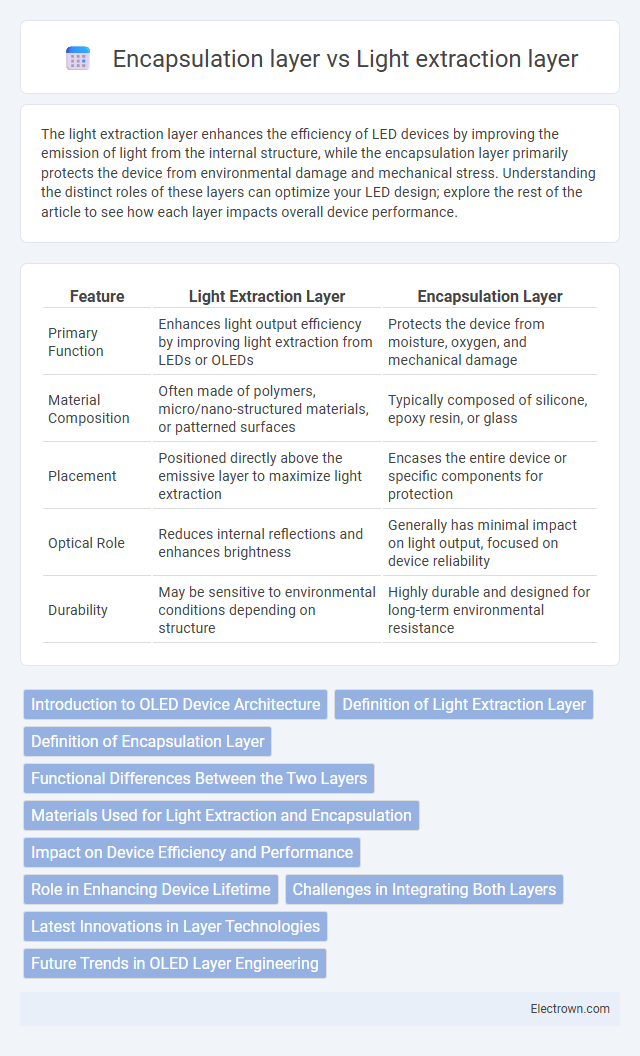The light extraction layer enhances the efficiency of LED devices by improving the emission of light from the internal structure, while the encapsulation layer primarily protects the device from environmental damage and mechanical stress. Understanding the distinct roles of these layers can optimize your LED design; explore the rest of the article to see how each layer impacts overall device performance.
Table of Comparison
| Feature | Light Extraction Layer | Encapsulation Layer |
|---|---|---|
| Primary Function | Enhances light output efficiency by improving light extraction from LEDs or OLEDs | Protects the device from moisture, oxygen, and mechanical damage |
| Material Composition | Often made of polymers, micro/nano-structured materials, or patterned surfaces | Typically composed of silicone, epoxy resin, or glass |
| Placement | Positioned directly above the emissive layer to maximize light extraction | Encases the entire device or specific components for protection |
| Optical Role | Reduces internal reflections and enhances brightness | Generally has minimal impact on light output, focused on device reliability |
| Durability | May be sensitive to environmental conditions depending on structure | Highly durable and designed for long-term environmental resistance |
Introduction to OLED Device Architecture
The light extraction layer in OLED device architecture enhances the efficiency by improving the emission of light from the organic layers to the external environment, reducing internal reflections and waveguide losses. The encapsulation layer provides a protective barrier against moisture and oxygen, ensuring device longevity and stability by preventing degradation of the organic materials. Together, these layers optimize both the performance and durability of OLED displays and lighting applications.
Definition of Light Extraction Layer
The Light Extraction Layer (LEL) is a specialized optical film designed to enhance the efficiency of light emitted from devices such as LEDs or OLEDs by minimizing internal reflection and maximizing light output. In contrast, the Encapsulation Layer primarily serves as a protective barrier against moisture, oxygen, and mechanical damage, preserving device longevity. You can improve your device's brightness and energy efficiency by integrating an effective Light Extraction Layer into the design.
Definition of Encapsulation Layer
The encapsulation layer is a protective coating applied over the active components of devices such as LEDs or OLEDs, designed to shield them from environmental factors like moisture, oxygen, and mechanical damage. Unlike the light extraction layer, which primarily enhances the efficiency of light emission by reducing internal reflection, the encapsulation layer ensures long-term durability and stability of the device. Effective encapsulation materials often feature high transparency and barrier properties to maintain device performance while preventing degradation.
Functional Differences Between the Two Layers
The light extraction layer primarily enhances the efficiency of light emitted from LEDs by reducing internal reflections and guiding more photons outward, thereby increasing brightness. In contrast, the encapsulation layer serves to protect the LED chip from environmental damage such as moisture and mechanical stress while maintaining optical clarity. These functional differences highlight the light extraction layer's role in optical performance improvement and the encapsulation layer's role in device durability and longevity.
Materials Used for Light Extraction and Encapsulation
Light extraction layers commonly utilize materials like silica aerogels, polystyrene, and specialized polymers with high refractive indices to enhance light emission efficiency by reducing internal reflection. Encapsulation layers primarily employ transparent silicones, epoxies, or urethanes that protect the LED device from moisture, mechanical damage, and environmental factors while maintaining optical clarity. Your choice between these layers depends on optimizing both light output performance and long-term device durability.
Impact on Device Efficiency and Performance
Light extraction layers enhance device efficiency by reducing internal light reflection and boosting external quantum efficiency, directly improving brightness and power output. Encapsulation layers, while primarily protecting against environmental degradation, influence performance by preserving device stability and longevity, indirectly sustaining efficiency over time. Optimizing both layers can significantly improve your device's overall luminous efficacy and operational durability.
Role in Enhancing Device Lifetime
The Light Extraction Layer improves device lifetime by efficiently guiding photons out, reducing heat buildup and preventing material degradation that commonly shortens OLED or LED performance. The Encapsulation Layer protects sensitive device components from moisture, oxygen, and mechanical damage, which are major factors in device aging and failure. Your device's longevity is maximized when both layers work synergistically to maintain optical efficiency and environmental stability.
Challenges in Integrating Both Layers
Integrating the Light Extraction Layer (LEL) with the Encapsulation Layer in OLED displays presents challenges in maintaining optical efficiency while ensuring device protection. The LEL requires precise geometry and refractive index matching to enhance light output, but the Encapsulation Layer must provide robust moisture and oxygen barriers without compromising these optical properties. Balancing these functionalities demands advanced materials and fabrication techniques to optimize Your device's performance and longevity.
Latest Innovations in Layer Technologies
The latest innovations in light extraction layers emphasize nanostructured surfaces and advanced photonic crystals to significantly enhance OLED efficiency by reducing internal light loss. Encapsulation layers now incorporate ultra-thin, flexible barrier films with improved moisture and oxygen resistance, extending device longevity while maintaining optical clarity. Together, these technological advances optimize both brightness and durability in next-generation display and lighting applications.
Future Trends in OLED Layer Engineering
The future trends in OLED layer engineering emphasize advancing Light Extraction Layers (LELs) to enhance luminance efficiency by minimizing internal light losses through nanostructured and photonic crystal designs. Encapsulation Layers are evolving with ultra-thin, flexible, and multi-functional barrier technologies that improve device longevity by preventing moisture and oxygen ingress without sacrificing flexibility. Innovations integrate both layers to create synergistic effects, optimizing brightness, durability, and device form factors in next-generation OLED displays and lighting applications.
Light extraction layer vs Encapsulation layer Infographic

 electrown.com
electrown.com